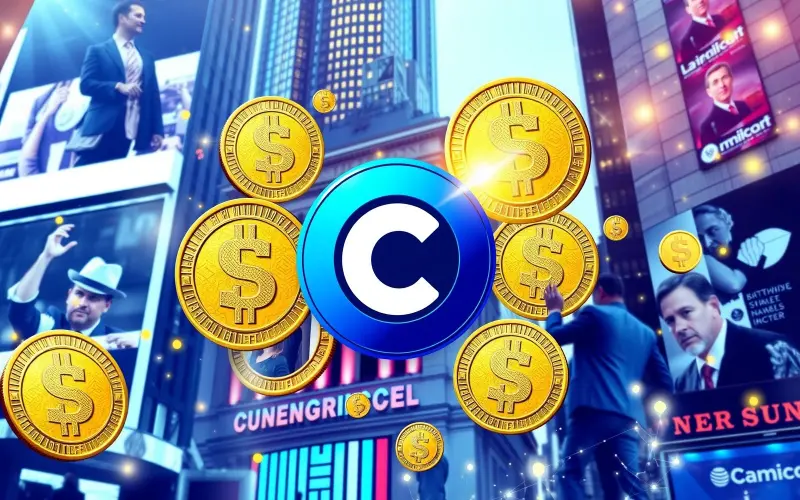Circle, the "first stablecoin stock," delivered its first earnings report since its IPO. Driven by a significant increase in the circulation of its pegged currency, the company's total revenue and reserve income increased 53% year-over-year to $658 million, but profits were significantly dragged down by significant non-cash charges. Furthermore, after the earnings report was released, Circle announced the sale of 10 million shares, sparking shareholder cash-out concerns. The stock price, which had surged 16%, then fell 5% after hours. However, the company remains confident in its profit outlook, believing that mainstream institutions will accelerate stablecoin adoption as regulatory compliance approaches.

Despite significant losses, impressive revenues were also impressive.
On August 12th, local time, Circle, the issuer of USDC, the world's second-largest dollar-denominated stablecoin, released its first quarterly financial report since its June IPO. Circle's financial report shows that total revenue and reserve income increased 53% year-over-year to $658 million, primarily driven by a significant increase in USDC circulation, exceeding analysts' expectations of $647.3 million.
However, the company still reported a loss in the second quarter due to non-cash expenses related to its IPO. Specifically, the second-quarter net loss was $482 million, or an adjusted loss per share of $4.48.
The majority of Circle's funding comes from interest income, particularly from the short-term Treasury bonds that back its stablecoin, USDC. Over the past three years, the company's revenue from managing stablecoin reserves has grown from $735.9 million in 2022 to $1.4 billion in 2023, and then to $1.7 billion in 2024, representing 95.3%, 98.6%, and 99.1% of Circle's total revenue from continuing operations, respectively.
In this context, when users purchase dollar-pegged stablecoins, the issuer receives corresponding USD funds. Therefore, the greater the market demand for dollar-pegged stablecoins, the greater the issuer's demand for US Treasury bonds. Users holding such stablecoins are essentially indirectly holding US Treasury bonds.
However, the latest financial report shows that the reserve return rate fell 103 basis points year-on-year to 4.1%, reflecting the impact of the changing interest rate environment on profitability. Meanwhile, the daily weighted average share of USDC on the platform was 7.4%. While this represented a 536 basis point year-on-year increase, the absolute level remained low, indicating that the majority of USDC was circulating on third-party platforms.
Following the release of the financial report, Circle's US stock price surged over 10% in pre-market trading, initially soaring 16% to nearly $190 at the opening. However, news soon followed of shareholder cashing out, with the company and shareholders, including co-founder and CEO Jeremy Allaire, announcing a joint sale of 10 million shares.
According to a filing with the US Securities and Exchange Commission on Tuesday (August 12), Circle plans to issue 2 million new shares, with existing shareholders selling 8 million shares. Following the announcement, Circle's stock price fell over 6% to $153 in after-hours trading in New York. This represents a nearly 50% drop from its all-time high of $299, but remains approximately five times higher than its initial public offering price of $31.
Active Circulation, Increasing Market Share
Circle went public in June of this year, raising $1.2 billion. With growing market acceptance, stablecoins are evolving from their initial role as leverage in the crypto market to becoming a universal payment medium, providing merchants and consumers with a cheaper and more efficient payment system.
Circle stated that as of June 30th, USDC's circulation had increased by 90% year-over-year to $61.3 billion, increasing its share of the fiat-backed stablecoin market to 28%.
According to the latest data from Coingecko, as of August 13th, USDC's circulating market capitalization exceeded $65 billion, ranking second in the global stablecoin market, behind only Tether's USDT ($165 billion). While there is still a gap in market share, Circle's regulatory background and high transparency in the disclosure of its US dollar assets are attracting more and more traditional merchants and payment networks to incorporate stablecoins into their settlement systems.
On July 18, US President Trump officially signed the "Guidance and Establishment of a National Stablecoin Innovation Act" (GENIUS Act) at the White House, marking the implementation of US stablecoin regulatory legislation. Analysts point out that the passage of the GENIUS Act is a significant boon to Circle's long-term compliance position. As the first stablecoin issuer to obtain regulatory compliance approval, Circle's competitive advantage in the new regulatory environment is likely to be further consolidated.
Circle also plans to launch its own blockchain, Arc, by the end of the year. According to the blockchain's lightweight white paper, Arc will not only use USDC as the native asset for transaction fees, but will also support other local stablecoins.
Some analysts point out that this move reflects broader industry trends. According to previous media reports, after acquiring the stablecoin platform Bridge last year, payment giant Stripe recently announced that it is building its own first-layer blockchain focused on payments; Robinhood has also disclosed plans for a second-layer blockchain.
In this regard, Seaport Research analyst Jeff Cantwell noted, "Circle is a global leader in the stablecoin space and currently the purest stablecoin on the public market. As the company continues to create new opportunities for itself and its partners, we expect its stock price to rise further." The analyst maintained a "Buy" rating on the stock with a target price of $280.
Distribution Concerns, Profitability Uncertain
Currently, the majority of Circle's revenue still comes from U.S. Treasuries and other yield-earning assets that support the value of its USDC token. A Standard Chartered Bank report projects that stablecoin issuance will reach $2 trillion by the end of 2028, generating an additional $1.6 trillion in demand for U.S. Treasury bills, "enough to absorb all new Treasury issuance during the remainder of Trump's second term."
In addition, Circle's revenue must be shared with other platforms. When USDC was first launched in 2018, Circle's brand and distribution capabilities were relatively weak. It relied on the cryptocurrency platform Coinbase's exchange status and user network to rapidly expand USDC market share, giving Coinbase a dominant position in partnerships.
The company stated that total distribution, transaction, and other costs increased 64% year-over-year to $407 million, primarily due to increased USDC circulation and the growth of USDC holdings on the Coinbase platform, which drove up distribution payments, as well as distribution expenses incurred through new strategic partnerships. In other words, 60% of Circle's revenue goes to Coinbase.
An industry insider told the Beijing Business Daily that Circle's IPO prospectus reveals three critical problems: First, its revenue is singular, with 99% coming from reserve funds and only 1% from other sources. Second, its costs are high, with 60% of its revenue going to Coinbase, resulting in a net profit margin of only 9%. Third, its profitability is unstable, with a net loss of $770 million in 2022, a profit of $270 million in 2023, and a drop back to $160 million in 2024.
"99% of its revenue comes from reserve funds, which means Circle has no other profit channels. This creates a significant valuation ceiling for a company."
The insider frankly stated, "Circle's profitability depends on two variables: first, the circulation of USDC. The larger the circulation, the larger the reserve assets, and the higher the interest income. Second, the interest rate environment. The US Treasury yield directly determines reserve income. A high interest rate environment is extremely beneficial to Circle. However, the Federal Reserve may be about to enter a rate cut cycle, and US Treasury yields may fall to 2% or even lower, which would directly cut Circle's profits in half."




